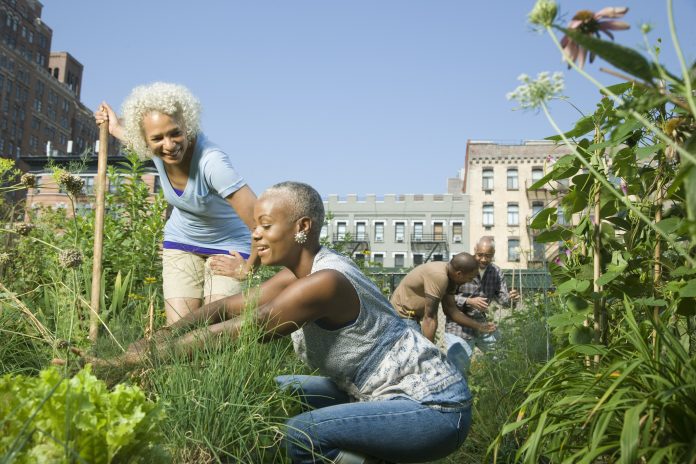
Results of a randomized, controlled trial show that taking part in a community gardening scheme may indirectly reduce a person’s cancer risk by boosting fiber intake, increasing physical activity, and decreasing stress and anxiety, all of which have been associated with the disease.
“Connecting people to gardens, a nature-based and socially supported local activity in the neighborhood can help people make the necessary changes to support active and healthy living, reduce stress and anxiety, all important ingredients for preventing disease and promoting health,” Jill Litt, a professor in the Department of Environmental Studies at the University of Colorado Boulder, told Inside Precision Medicine.
Litt and her team, funded by the American Cancer Society, carried out the first ever randomized, controlled trial of community gardening between 2017 and 2019. In all, 291 non-gardening participants took part in the study. They were all on community garden waiting lists in Denver and Aurora and had an average age of 42 years. Just over a third were Hispanic and more than half came from low-income households.
In May of each recruitment wave, after the last spring frost, half of the participants were assigned to a community gardening group and half to a control group that was asked to wait a year before they started gardening.
Those in the gardening group received a free community gardening plot, some seeds and seedlings, and an introductory gardening course through the nonprofit Denver Urban Gardens and a study partner. Participants in both groups completed surveys on nutritional intake and mental health, underwent body measurements and wore activity monitors during spring, autumn, and winter.
Litt and co-authors report in The Lancet Planet Health that, by autumn, individuals in the gardening group were eating, on average, 1.4 g more fiber per day than those in the control group—an increase of about 7%.
The estimated mean fiber intake for US adults is 15.9 g per day, which is much lower than the recommended intake of at least 25 to 38 g per day, the investigators report. The increase of 1.4 g was not far off the 2.0 g increase observed in a study looking at the pooled effect of interventions to promote healthy diet on the consumption of dietary fiber.
“An increase of one gram of fiber can have large, positive effects on health,” said co-author James Herbert, director of University of South Carolina’s cancer prevention and control program.
And Litt noted that fiber “exerts a profound effect on inflammatory and immune responses, which is why it is important from a disease prevention and health promotion perspective.”
She added: “It is also associated with phytochemicals (found in fresh foods such as vegetables and fruits) that are, themselves, universally anti-inflammatory. Increasing any amount of fiber puts one on a path to reduced inflammation and reduced risk of metabolic dysregulation, which has implications for many chronic diseases.”
However, the study was not specifically focused on nutrition and the investigators did not give out any health advice. “We gave people the tools and plants they needed to get started. I imagine, with more time in the garden, fiber intake will increase as people learn how to garden and learn what to do with the produce they grow,” Litt remarked.
The gardening group also increased their moderate-to-vigorous physical activity levels by nearly 6 minutes per day, or 42 minutes per week, relative to the control group.
“Most people do not meet national and international guidelines for active living. Increasing moderate to vigorous activity by 42 minutes represents almost 30% of the recommendation of 150 minutes of this type of physical activity,” said Litt.
She also pointed out that physical inactivity is an important risk factor for chronic disease, including cancer. “Getting people to move more is important for physical and mental health because it can reduce inflammation, improve immune system function, improve metabolism and prevent obesity or control body weight. It also can prevent high blood levels of insulin, which can increase risk of cancers of the breast and colon.”
Finally, the researchers observed that participants in the gardening group reported greater reductions than the control group in both perceived stress and anxiety between spring and autumn, with the level of reduction greatest among participants who were more stressed or anxious at baseline.
Importantly, the study showed that being new to gardening is not a barrier to being successful and that community gardens can be a solution for populations from diverse backgrounds and circumstances as the effects did not differ by race, ethnicity, age, or sex.
Litt, who is also a researcher with the Barcelona Institute for Global Health, believes her findings highlight the importance of improving access to and interest in initiatives like community gardening.
“Gardens should be recognized as a primary and permanent natural space, similar to playgrounds, public plazas and other aspects of the social infrastructure of communities,” she said. “This can be accomplished through planning tools such as master and neighborhood plans, zoning ordinances, long-term land leases and collaboration with local utilities like public water and wastewater entities to ensure access to a reliable supply of water during the growing season.”
“Additionally, local and state health departments can serve as important partners to ensure the soil is safe and managed appropriately. Finally, engaging local and regional foundations is critical to ensure there are resources available to support garden organizations to build, retrofit and maintain gardens over time.”





